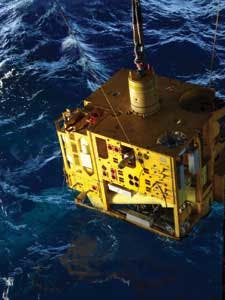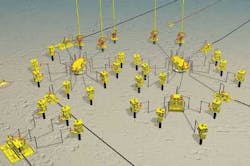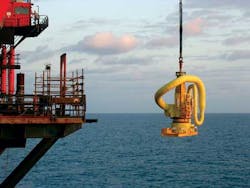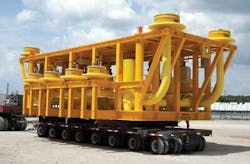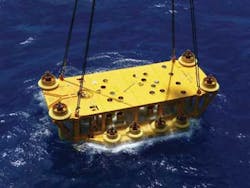The Subsea System
Two related technologies make the subsea portion of the Perdido project viable: the subsea boosting system, and a surface blowout preventer for drilling and completing the direct vertical access subsea wells. A total of 22 wells will be drilled from the Perdido spar and another 13 will be offset wells with tiebacks to the host platform.
The final development plan may seem like an obvious solution now, but there were many questions early on, and some of the technology is being used for the first time. G. T. Ju, Subsea Team lead, joined the Perdido project at the beginning of 2003, almost immediately after results came in from the discovery well.
“Very early in the project we recognized that with these water depths, low reservoir temperature and pressure, and the huge uncertainty of the reservoir’s deliverability, that if the project were to go forward, we had to minimize the risk,” Ju says. “We needed some sort of subsea boosting or artificial lift technology to put energy into the flow system.”
The team’s next decision was which technology to use. Was it best to put electric submersible pumps (ESPs) in the wells, or better to use multiphase pumps on the riser base to move all the fluids and gas to the surface?
The Perdido development consists of three main oil-bearing reservoirs, each with distinctly different fluid properties. The oil ranges from moderately heavy to light, with gravities from 17 to 40 degrees API. Gas volumes at the mud line are quite large, so multiphase pumps would be too inefficient to consider. Typical gas/oil ratios (GORs) at Perdido range from 500 scf to 2,000 scf per barrel of oil. Even if multiphase pumps could be used initially, they would become less efficient or cease to function altogether as the GORs changed over time. Electric submersible pumps in the wellbore were also ruled out, because of the huge cost of replacing them in the future.
Ju’s team settled on a third option, one that had never been tried before: subsea separators, plus subsea boosting pumps to get liquids to the surface.
“We’re using a two-phase separation system on the seabed, flowing gas to the surface and pumping only the liquids,” Ju says. “That gives us two advantages. One is energy efficiency, but it also extends the lives of the pumps. If the equipment is just moving liquid, it is much better than pumping a mix of liquids and gas.”
The second advantage to a two-phase system is that it takes out the subsurface uncertainty. “This is a new reservoir,” Ju says. “There is no producing analog to tell us how the gas/oil ratio is likely to change over time. By separating gas from the rest of the produced fluids on the seabed, we don’t have to worry about the potential changes over the life of the reservoir, or the differences between our three main reservoirs. Subsea boosting, with two-phase separation and single-phase pumping became our obvious choice.”
Hardware on the seabed
The core of Perdido’s subsea boosting system (SBS) is a cluster of five vertical gas-liquid cylindrical cyclonic (GLCC) separators. The body of each separator is a heavy pipe, 35 inches in diameter and 350 feet long. Production from all of the wells comingles in these vessels. The primary function of the caissons is to provide a surge volume for the separated production liquids. The passive system relies on centrifugal force to separate gas and liquids as they swirl down the outer walls of the caisson.
All but the uppermost portion of the separator is inserted into the seabed. A 1,600-horsepower electric submersible pump (ESP) is deployed inside, near the bottom of the vertical caisson.
At the top of the separator, just above the mud line, sits a 2-story tall inlet assembly. Above that, a 17-foot-long reducer brings the diameter of the pipe down to 14 inches, matching the diameter of the riser. From there, the riser extends some 7,800 feet to the Perdido spar.
Each caisson’s inlet assembly connects to the host through a top-tensioned riser that contains three separate flow paths. The outer annulus of the riser carries the relatively dry gas. The middle annulus carries produced liquids, which are pushed to the surface by the power of the ESP at the bottom of the separator caisson, and a small diameter pipe in the center carries liquid sent down from the surface to prime and cool the submersible pump. The 14-inch riser allows direct vertical access to the boosting pump at the bottom of the caisson.
Subsea trees and manifolds
With the water depth at Perdido approaching 10,000 feet, using Shell’s existing first generation standard tree system was not an option, since it is designed for water no deeper than 7,500 feet. In planning Perdido’s subsea trees, the team also wanted to update the seals, actuators, materials and connectors, and to be able to accommodate a wider range of deployment and intervention options.
The new standard tree system they developed incorporates Shell’s experience with previous deepwater installations as well as some recent innovations. The new system is rated for 10,000 psi and 10,000 feet of water depth. It has a retrievable flow module that contains both a multiphase flow meter and a choke. The tree’s modular design allows it to be configured for the requirements of the field, and its compact, lightweight components make it easier to service and deploy than previous systems.
All of Perdido’s wells are being drilled either from the spar itself, or from moored or dynamically-positioned floaters with single or dual derrick systems. That difference in drilling systems led to some variety in the way the subsea trees were installed.
The surface BOP
The idea of using wet-tree wells with direct vertical access from the spar helped minimize the size of the host platform. All of the drilling, completion and subsequent maintenance of the spar’s 22 wells can be completed using the onboard rig. The rig is held in a fixed position over a well by adjusting the mooring lines on the spar. Tension on the mooring lines can be adjusted to reposition the rig over a different slot.
This system is significantly less expensive than using a 5th generation floating rig to complete and service the wells.
Perdido’s onboard capability includes a custom wellhead, riser and blowout preventer (BOP) system. The surface BOP is a custom made 16-3⁄4-inch unit with a rating of 5,000 psi. It is connected to a top-tensioned, high pressure drilling and completion riser (DCR), which was also designed specifically for the Perdido project.
“Unlike surface BOP operations from floaters, no subsea isolation device is needed on the bottom of the riser, because the spar’s rig is considered to be a permanently moored structure,” Ju says. “The DCR is designed to stay connected if the rig has to be abandoned for a hurricane.”
For most drilling and completion activities, well operations are similar to dry-tree DVA wells. The most significant challenge in completing subsea wells with a surface BOP is running and landing the subsea tubing hanger with a subsea isolation device.
“We had to address three main issues,” Ju says. “First, the umbilical lines required double terminations if a surface spanner joint was used. Second, we needed a way to pressurize the annulus for testing, and third, we needed to reduce the size and weight of the conventional installation and workover control systems (IWOCS) umbilical for this water depth.”
The Perdido solution is a hybrid configuration in which the IWOCS umbilical is replaced by two six-line flat packs for the hydraulic functions, and a single line for the electrical connection. The lines are run with the landing string, just as the control lines are run with the production tubing, so it is not necessary to have a surface spanner.
Maturing the technology
Ju’s subsea team had a lot of confidence that their system would work, but the fact was, no one had tried it before.
“It was a major challenge,” Ju recalls. “We had to show senior management across three major oil companies, Shell, BP and Chevron, that the whole investment could hinge on the success of this technology. At this very early phase, when we really didn’t have a project yet, we were asking for several million dollars to mature the technology and convince managers that subsea boosting and separation would work.”
With a test budget approved, the subsea team devised a technology maturation process to prove that the system could function in 8,000 feet of water. A pilot test at that water depth was out of the question, so the team did the next best thing.
“We convinced the venture that subsea boosting and caissons with ESPs would be a good thing to do,” Ju says. “And to demonstrate the system, we built a flow loop at Shell’s Gasmer research facility in Houston.”
“At the Gasmer facility, we built a full scale flow loop of everything that would be below the inlet assembly head,” Ju says. “We could generate 55 million scf of nitrogen and pump 30,000 barrels of mineral oil through a system to simulate the concept.”
That allowed the subsea team to see how the separator caisson worked, how the controls worked and if the system was efficient. The Gasmer facility was used extensively for more than a year. Practice sessions taught operators how to run the system and how to start the electric submersible pump using additional fluid from the spar. The testing, which was completed in 2007, gave Ju’s team and managers of the JV partners the confidence to invest in the new technology, even without a pilot installation in the field.
“With the integration of wet-tree DVA and subsea boosting, we were able to reduce the diameter of the spar from 180 feet down to 118 feet,” Ju says. “That directly affected the cost of the spar and the weight of the topsides. Not only were we able to mitigate the subsurface risk, we reduced the total project cost. We took some risk with new technology, but in reality, subsea boosting and separation was the enabler that allowed us to do this project.”
Installing the SBS
The subsea team grew to 60 people during 2008 and 2009, the peak of the installation phase. The effort – concentrated around the Perdido hub – required lots of coordination.
“We had to work between two major activities,” Ju explains. “One was the installation of the spar, because some or our equipment had to go in first. The other major activity that competed with our portion of the installation was the topsides, because we could not complete the subsea work until the topsides was in place. That made the subsea installation a two-stage process.”
Flow assurance
The inherent challenges of Perdido, including the extreme water depth, low reservoir energy and challenging project economics, meant that flow assurance was critical. To understand the potential problems, the subsea team analyzed well fluid samples and conducted thermal-hydraulic studies at the onset of the project feasibility assessment. That allowed key flow-assurance considerations to be incorporated into the appraisal well campaign, then carried over into concept selection and project execution.
Working in a hot market
The Perdido development was sanctioned at the end of 2006. Soon after, the oil and gas market picked up and it became difficult to get equipment and to find skilled people to work on the project.
“Quality was a major issue,” Ju says. “Everybody in the industry was rushing. It was hard to get products delivered on time.”
Subsea tree
That became an increasing challenge during 2007 and 2008.
“We were scheduling everything around two major activities. In an overheated market, you need to deliver in time, otherwise you miss the installation window. We constantly juggled the installation schedule. Nothing could happen too early or too late. We had to manage the whole vendor community to deliver our equipment in time, and that became quite an art.”
Unlike the spar construction, the Subsea team served as the general contractor for the project manager. As such, the team itself managed its portion of the project and issued more than 100 purchase orders to different vendors. The largest of the purchase orders went to FMC, which provided the trees, manifolds, tie-in kits and some of the subsea boosting equipment. Heerema installed the flowlines and manifold, and many smaller vendors provided other equipment and things such as chemicals and services during commissioning.
“The team effort it took to deliver such a challenging project in that kind of tight market condition was amazing,” Ju says. “We also had a great relationship with Chevron and BP. Although the JV partners were not required to contribute directly to the design and fabrication, installation or commissioning of the subsea equipment, they were very supportive. They came to our subsea team meetings and offered their candid opinions. It has been a constructive relationship and a very friendly working environment.”
Continuous focus on safety
Everyone who has been associated with Perdido comments on the lasting culture of safety it has fostered. Those who have been with the project the longest add that the continuity of the personnel – some who were involved from the discovery well through final commissioning – has also contributed to the project’s success.
“I’ve had people who have been with me for six years,” Ju says, “and I have been with the project for more than seven years. Our project manager, Dale Snyder, set an almost impossible safety goal, but through the entire subsea construction and commissioning we had only one recordable incident. That kind of performance is impressive.”

